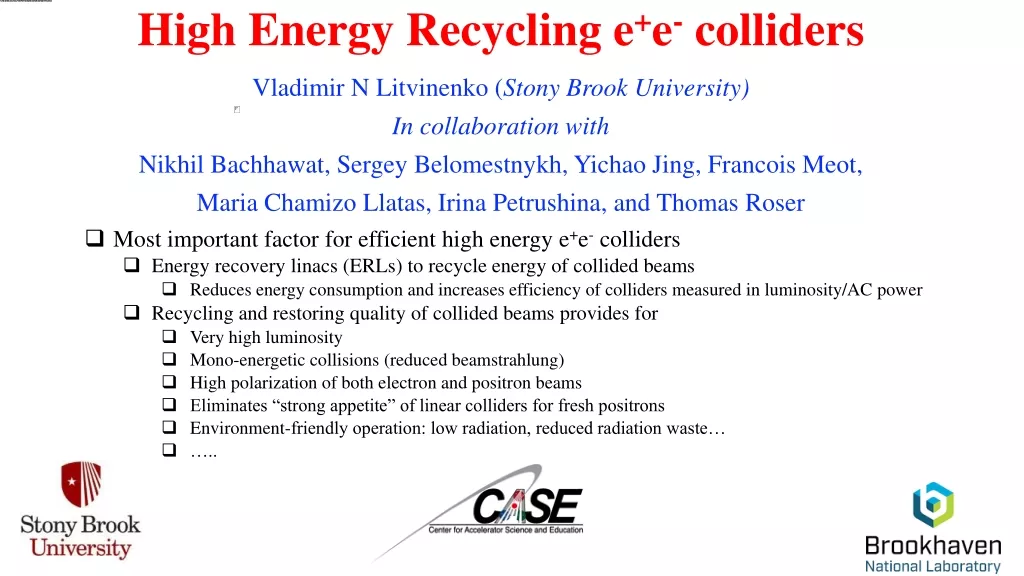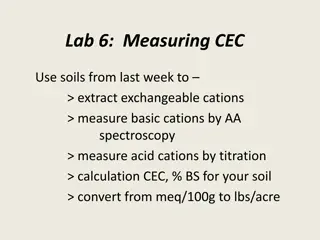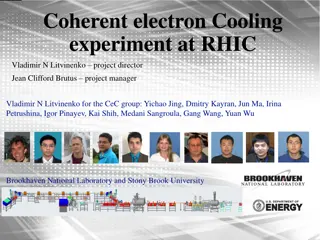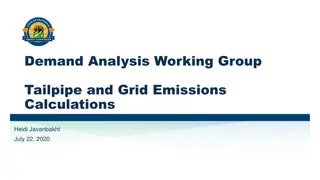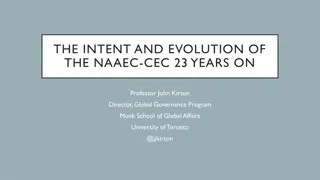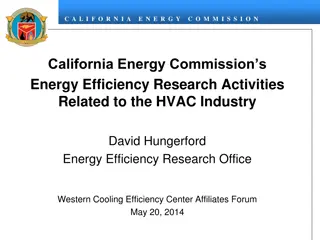
Challenges and Solutions for High Luminosity in Electron-Ion Collider Programs
Explore the critical need for Coherent Electron Cooling (CeC) in achieving high luminosity for the success of future electron-ion collider (EIC) programs. Discover how CeC enhances integrated luminosity and the common factors of CeC schemes. Delve into CeC options and their operations at various frequencies, amplifiers, and modulators. Compare CeC options with EIC designs to understand their impact on luminosity enhancement.
Download Presentation

Please find below an Image/Link to download the presentation.
The content on the website is provided AS IS for your information and personal use only. It may not be sold, licensed, or shared on other websites without obtaining consent from the author. If you encounter any issues during the download, it is possible that the publisher has removed the file from their server.
You are allowed to download the files provided on this website for personal or commercial use, subject to the condition that they are used lawfully. All files are the property of their respective owners.
The content on the website is provided AS IS for your information and personal use only. It may not be sold, licensed, or shared on other websites without obtaining consent from the author.
E N D
Presentation Transcript
Why CeC is needed? High luminosity of US future electron-ion collider(EIC) is critical for success of its physics program 2018 NAS Assessment of U.S.-Based Electron-Ion Collider Science states: The accelerator challenges are two fold: a high degree of polarization for both beams, and high luminosity. CeC is the most promising technique for boosting the EIC luminosity 2018 eRHIC pCDR review states: The major risk factors are strong hadron cooling of the hadron beams to achieve high luminosity, and the preservation of electron polarization in the electron storage ring. The Strong Hadron cooling [Coherent Electron Cooling (CeC)] is needed to reach 1034/(cm2s) luminosity. Although the CeC has been demonstrated in simulations, the approved proof of principle experiment should have a highest priority for RHIC
What CeC can do for EIC Integrated Luminosity boost eRHIC R-R - at least 4-fold; eRHIC L-R at least 10-fold JLEIC R-R - ~ 5-10(?) JLEIC at 100 GeV c.m.
What is common for all CeC schemes Relativistic factor the e-beam should match that of the proton beam 100 GeV p -> 54.46 MeV e- 275 GeV p -> 149.8 MeV e- In practice e-beam is needed at all energies from 20 MeV t0 150 MeV All need fresh beam with tens or hundreds of mA and e-beam power 1 MW to 50 MW Energy recovery linac are the MUST as the driver
What are CeC options all operating at ~ 300 to 1,000 THz with a free-electron laser (FEL) amplifier Bandwidth ~ 25 THz with a single-stage chicane-based micro-bunching amplifier (MBA) Eh Dispersion section ( for hadrons) Kicker Hadrons Very low gain Modulator I E > Eh R56 Electrons Single-Buncher Amplifier with a multi-stage chicane-based micro-bunching amplifier (MBA) Eh Dispersion section ( for hadrons) Kicker Full Hadrons Modulator I E > Eh Micro-bunching Amplifier -R56/4 Bandwidth -R56/4 -R56/4 R56 Modulator 2 Modulator 5 Electrons with a micro-bunching plasma-cascade amplifier (PCA) Kicker Modulator Hadrons Full Bandwidth Electrons with an hybrid laser-beam amplifier (HA) E < Eh Eh Dispersion section ( for hadrons) Kicker Hadrons Modulator E > Eh Laser Amplifier R56 Radiator Energy modulator Electrons
CeC options vs EIC design with a free-electron laser (FEL) amplifier eRHIC R-R v with a single-stage chicane-based micro-bunching amplifier (MBA) Eh Dispersion section ( for hadrons) Kicker Hadrons Modulator I E > Eh NONE R56 Electrons Single-Buncher Amplifier eRHIC R-R v eRHIC R-R v JLEIC v with a multi-stage chicane-based micro-bunching amplifier (MBA) Eh Dispersion section ( for hadrons) Kicker Hadrons Modulator I E > Eh Micro-bunching Amplifier -R56/4 -R56/4 -R56/4 R56 Modulator 2 Modulator 5 Electrons with a micro-bunching plasma-cascade amplifier (PCA) eRHIC R-R v eRHIC R-R v JLEIC v Kicker Modulator Hadrons Electrons with an hybrid laser-beam amplifier (HA) E < Eh Eh Dispersion section ( for hadrons) Kicker Hadrons Modulator E > Eh Laser Amplifier R56 Radiator Energy modulator Electrons
Relative cost of the CeC options with a free-electron laser (FEL) amplifier ~80% with a single-stage chicane-based micro-bunching amplifier (MBA) Eh Dispersion section ( for hadrons) Kicker Hadrons Modulator I E > Eh Not needed R56 Electrons Single-Buncher Amplifier with a multi-stage chicane-based micro-bunching amplifier (MBA) Eh Dispersion section ( for hadrons) Kicker Hadrons Modulator I E > Eh FULL price Micro-bunching Amplifier -R56/4 -R56/4 -R56/4 R56 Modulator 2 Modulator 5 Electrons with a micro-bunching plasma-cascade amplifier (PCA) Kicker Modulator Hadrons ~50% Electrons with an hybrid laser-beam amplifier (HA) E < Eh Eh Dispersion section ( for hadrons) Kicker Hadrons Modulator E > Eh Laser Amplifier R56 Radiator Energy modulator Electrons
Other requirements Charge per bunch - 1 nC to 2.5 nC Rep-rate: eRHIC R-R 112.6 MHz eRHIC L-R 9 (28) MHz JLEIC R-R 476 MHz Normalized emittance 1 to 10 m Relative energy spread 10-4 to 10-3
Specific combinations* EIC eRHIC RR eRHIC RR eRHIC RR eRHIC LR JLEIC 200 GeV CeC amplifier FEL MBEC PCA PCA PCA Charge/ bunch nC 2.5 1 1 5 1 Peak current, A 10 30 250 250 200 Normalized emittance, mm mrad <10 ~ 1 4 4 4 Relative energy spread, RMS 3x10-4 10-4 3x10-4 3x10-4 3x10-4 Rep-rate, MHz 113 113 113 9 475 Average current, mA 280 113 113 45 476 Cooling time, min <60 <60 <60 < 1 ~1 *Some numbers in this table are estimations
Conclusions ERL are accelerator of choice for any IEC Coherent electron Cooling system Beam energies from 20 MeV to 150 MeV are needed to cover all range of the proton energies in EIC Charge per bunch depend on design and varies from 1 nC to 5 nC Normalized emittance depends on the scheme and the most relaxed for FEL amplifier (10 m) and most stringent (1 m) for traditional micro-bunching amplifier Energy spread requirements are typically 0.03% RMS, with exception of for traditional micro-bunching amplifier it requires 0.01% RMS energy spread Average beam current depends on EIC design and varies from 45 mA (eRHIC L-R) to 115-280 mA (eRHIC L-R) and nearly half of the amp for JLEIC


